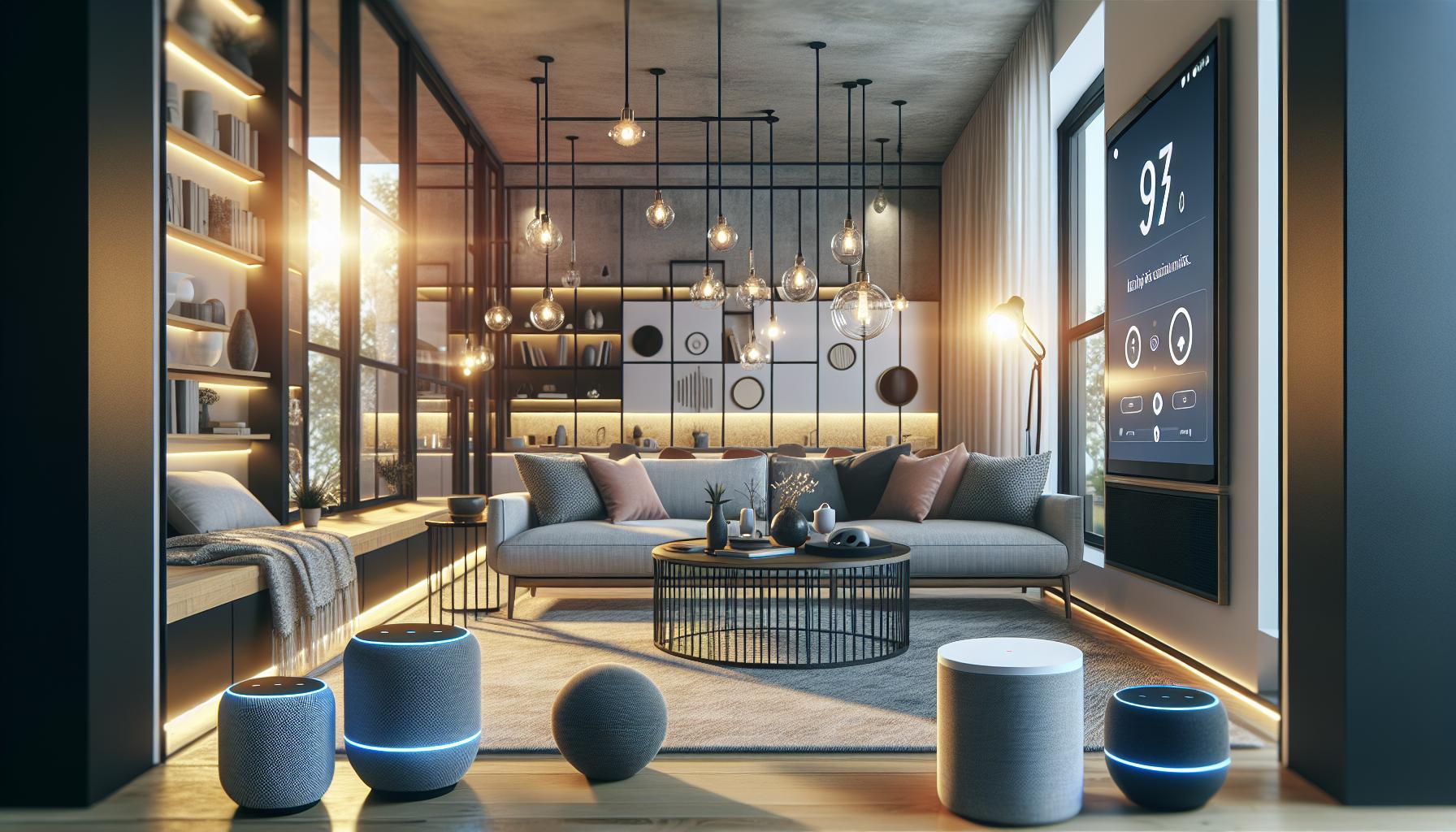In a world where your toaster can chat with your fridge, controlling IoT-connected smart devices has never been more essential—or entertaining. Imagine waking up to the smell of freshly brewed coffee, all thanks to your smart coffee maker that’s already plotting your caffeine fix. But how do you tame these tech-savvy gadgets without losing your sanity?
How Can You Control an IoT-Connected Smart Device?
IoT-connected smart devices integrate technology into everyday appliances. They enhance home automation, creating seamless interactions among devices. Smart thermostats, for instance, allow users to control home temperature remotely, improving energy efficiency.
Connectivity defines these devices, enabling communication through the internet. Devices like smart lights and security cameras respond to commands from smartphones or voice-activated assistants. Users can adjust their settings using dedicated apps or web interfaces, providing convenience at their fingertips.
Variety exists among IoT devices, catering to diverse needs. Home security solutions include smart locks that notify users of any unauthorized access. Smart kitchen appliances streamline meal preparation, allowing remote operation during cooking.
Interoperability becomes crucial when managing multiple devices. Some platforms support integration across various brands and types. This compatibility enables users to create customized routines, such as turning off lights when leaving home.
Data security remains a key consideration. Users must understand how to configure device settings to safeguard personal information. Regular updates and strong passwords mitigate potential security risks.
Choosing the right smart devices depends on individual preferences and lifestyle needs. Assessing features and compatibility ensures users select appropriate devices for their homes. Ultimately, managing these devices effectively enhances daily convenience and peace of mind.
Types of Control Methods

Controlling IoT-connected smart devices occurs through various methods that enhance user convenience. These methods include mobile applications, voice assistants, and web interfaces.
Mobile Applications
Mobile applications provide an intuitive way to manage smart devices. Users install specific apps to connect and control various devices from their smartphones. Features like remote access enable users to monitor appliances, adjust settings, or receive notifications on the go. For instance, a smart thermostat app allows users to set temperatures or create schedules easily. Many popular devices offer dedicated apps that enhance functionality, leading to a seamless user experience.
Voice Assistants
Voice assistants enable hands-free control of smart devices through simple voice commands. Platforms such as Amazon Alexa, Google Assistant, and Apple Siri integrate with numerous smart home devices. Users activate features without needing to navigate applications or interfaces. For example, saying “turn off the living room lights” prompts the voice assistant to execute the command immediately. This method underscores convenience while promoting multitasking throughout the home.
Web Interfaces
Web interfaces offer another effective control method for IoT devices. Accessing devices through web browsers provides an alternative to mobile applications. Users can log into dedicated websites to manage their smart devices from any computer. Graphical user interfaces often display device status, settings, and customizations in one view. For example, homeowners might adjust security camera settings or monitor energy usage from a central dashboard. This flexibility ensures users maintain control regardless of their preferred device.
Security Considerations

Securing an IoT-connected smart device involves multiple layers of protection. Ensuring device security starts with implementing strong passwords and enabling two-factor authentication. Regular firmware updates address vulnerabilities, enhancing overall safety. Additionally, users must manage privacy settings to limit data sharing options. Manufacturers often provide guidance on securing specific devices; following these recommendations helps maintain a secure environment.
Ensuring Device Security
Device security requires proactive measures. First, always utilize unique passwords for each device, avoiding reuse across different accounts. Next, consider segmenting the home network to isolate IoT devices from personal gadgets. Implementing network firewalls can further protect devices from unauthorized access. Monitoring network traffic also ensures no suspicious activities go unnoticed. Employing these strategies fortifies a home against potential threats.
User Privacy Concerns
User privacy remains a critical issue with IoT-connected devices. Many devices collect personal data, raising concerns about how that information is used. Understanding privacy policies assists users in making informed decisions about their data sharing. Configuring devices to limit data collection reduces risks associated with unwanted exposure. Implementing privacy settings strengthens user control, ensuring personal information stays protected. Choosing reputable brands that prioritize privacy practices fosters trust in technology interactions.
Best Practices for Control

Effective control of IoT-connected smart devices relies on implementing best practices. Prioritizing security and monitoring enhances user convenience.
Regular Updates
Regular updates play a critical role in maintaining device security. Device manufacturers frequently release firmware updates to fix vulnerabilities and enhance performance. Users must enable automatic updates where available. Checking for updates manually offers an additional layer of protection. Keeping devices up to date prevents exploitation of known security flaws. Ignoring updates can leave devices susceptible to cyber threats. Following manufacturer guidelines regarding update frequencies ensures optimal performance.
Monitoring Device Activity
Monitoring device activity is essential for maintaining control. Tracking usage patterns helps identify irregular behaviors, which may indicate security issues. Users can leverage mobile applications or web interfaces to access activity logs. Analyzing the logs assists in determining whether unauthorized access has occurred. Users should receive notifications for unusual activity to act swiftly. Implementing alerts fosters a proactive security approach, allowing for adjustments in device settings. Regularly reviewing settings also empowers users to safeguard privacy while enjoying the benefits of smart technology.
Future of IoT Device Control
The future of IoT device control is characterized by increased integration and enhanced user experience. Innovations in artificial intelligence will enable smart devices to learn user preferences, adjusting their functions accordingly. This adaptability leads to more intuitive control methods, reducing the need for manual adjustments.
Expect voice commands to become even more sophisticated, allowing for natural conversations with devices. Users might control multiple devices simultaneously, creating a seamless ecosystem. Integration with advanced technologies like 5G will enhance connectivity, providing rapid response times and improved reliability.
Moreover, interoperability among different brands will likely expand, enabling a broader range of devices to work together seamlessly. This advancement allows users to create complex routines, such as adjusting lighting and temperature for specific activities with a single command.
Robust data security measures remain a priority as more devices come online. Implementing advanced encryption and continual updates will protect user information and mitigate threats. Users may also gain more control over their data, choosing what is shared and with whom.
User-centric designs will emerge, focusing on accessibility and ease of use. Individuals with varying levels of technical knowledge will find it simpler to manage their smart homes. This trend ensures that the benefits of IoT technology are accessible to a wider audience.
As the landscape evolves, privacy considerations will become central to product development. Users are likely to demand transparent privacy policies and easy-to-manage settings. In response, manufacturers may prioritize building trust with customers by emphasizing privacy-first designs.
In this evolving environment, the future of IoT device control promises to deliver convenience, efficiency, and security, transforming everyday living into a more enhanced experience.
Mastering the control of IoT-connected smart devices is essential for enhancing everyday convenience and security. By utilizing mobile applications voice assistants and web interfaces users can seamlessly manage their devices while enjoying the benefits of home automation.
Prioritizing data security and privacy is crucial in this digital age. Regular updates and proactive monitoring help safeguard personal information while maintaining optimal device performance.
As technology continues to evolve the future promises even greater integration and user-friendly experiences. Embracing these advancements will empower users to create smart homes that reflect their unique lifestyles and preferences.



